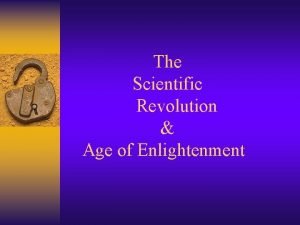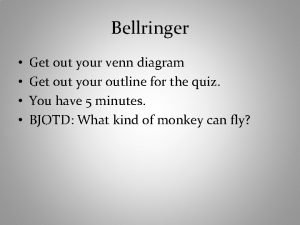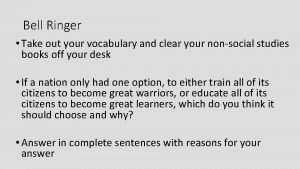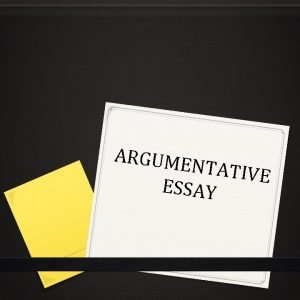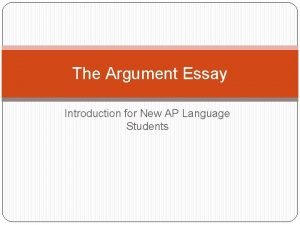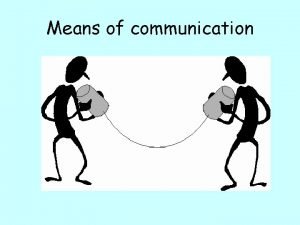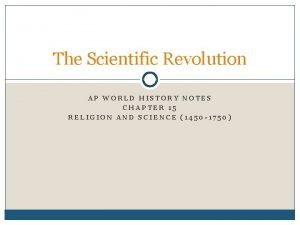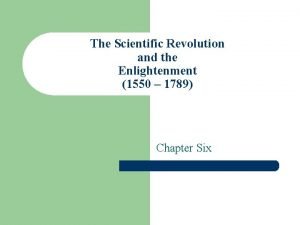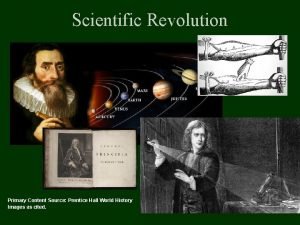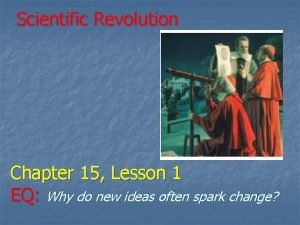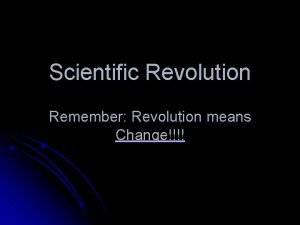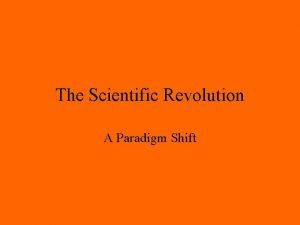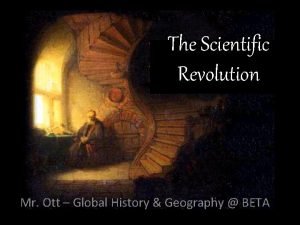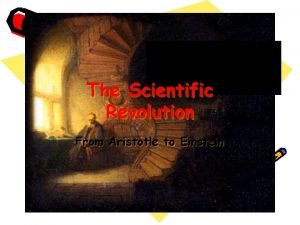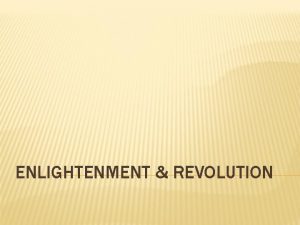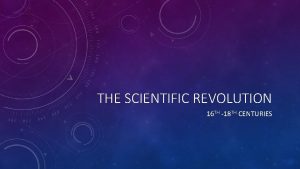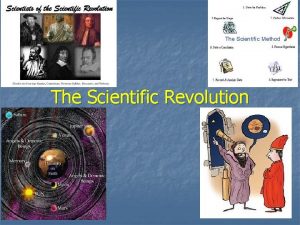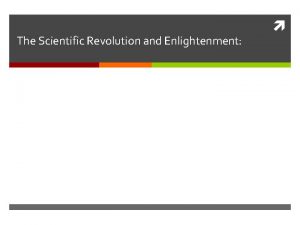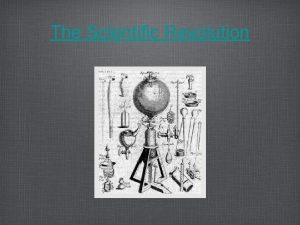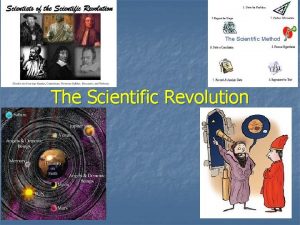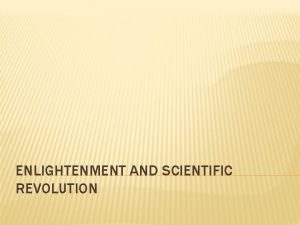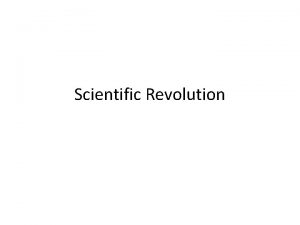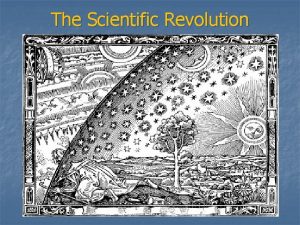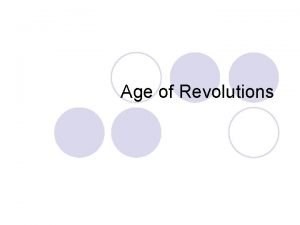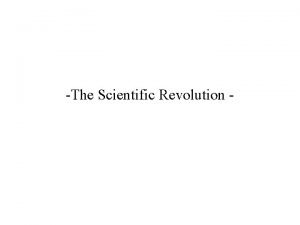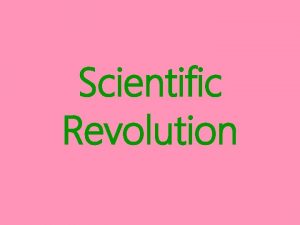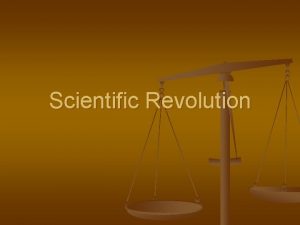Scientific Revolution 16 th and 17 th Centuries























- Slides: 23

Scientific Revolution 16 th and 17 th Centuries

The Scientific Revolution • Re-examining and re- thinking theories from the past • Blending of older knowledge and new discoveries • Not a formal science until late 17 th century • Natural philosophy • Most who studied sciences worked in universities or in the court of a prince

Mechanism • Impacted all philosophers of the time • Used mechanical metaphors or language of machinery to explain the world • Abandoned ideas of spiritual purpose and mystery in nature • God= mechanic, arranged the world as a machine that would function automatically • Increased emphasis on mathematics • A switch from symbolic meaning to an emphasis on the usefulness of nature

A Need for Institutions • Some scholars wanted to preserve ideas of ancient thought- reluctant to embrace new ideas • Many “new” scholars felt the need for reforms in educational institutions • Assimilation of new ideas was slow and disjointed

Royal Academy of Sciences, Paris

Institutes of Sharing • Places where ideas would be gathered, exchanged, and debated • Listened to papers, observed experiments, created libraries, published information • Experiments received credibility • Separated natural philosophy from religious and political disputes • Promoted civility- attracted people to their ideas

Zoology & Biology A dissection at the Royal Academy, London

Science and Government • Scientists used info and skills from a variety of people within the community – Craftspeople, sailors, workers • Natural philosophers improved production, navigation, and military artillery

Women and the Scientific Revolution • Women had been excluded from intellectual life • Denied membership in societies • Noblewoman and women from artisan class- had the most rights • Work was often credited to their male counterpart • Believed that women’s minds were dif. And inferior to male’s

Science and Religion • Theories and discoveries went against biblical statements about the heavens • Who would decide conflicts between religion and science – Church authorities or natural philosophers • New science seemed to replace religion

The Solutions • Scientists’ thought showed their support of religious ideals • Science and religion are compatible- mutually supportive • New ideas of science and religion could solve religious disputes • New ideas are a part of a divine plan • God put humans on earth to understand it • Humans were meant to improve the world through rational though

Witch-Hunts • New ideas cause anxieties about death, sin, and the devil • Believed in magic • 1400 -1700= ~100, 000 people killed for magic and witchcraft • Witches accused of cannibalism, performing rituals, harming neighbors and attending sabbats – Large meetings where they flew

Why Witch-Hunts • Religious conflicts and warfare • Reformation- took away traditional defense against devil • Monarchs and popes acceptance in order to gain loyalty

Origins of Witch-Hunts • History of “witches” helping people deal with disasters through magic • Mostly old, poor single, or widowed women • A way of opposing Christian society’s demands on the countryside • Peoples belief in magical power fostered witch-hunts

Clergy and Witchcraft • Clergy also claimed certain “magical” powers – Eucharist, penance/confession, power to cast out demons • Church’s magic= only magic • Those who practiced magic outside of the church were under the influence of the devil • Witch-hunts- a way for govt. and church to have political and religious control over a community

About a Witch • Mostly women over 40 • Could’ve been a conspiracy of males against females • Mostly from three groups – Widows, midwives, and women healers

An End to Hunting • Mind and matter- two separate realities – Thoughts in mind or words spoken can’t alter physical things • A witch’s curse was only words • Increase in medicine and lawyers= new security • Things just got out of control – Tortured witches accused community and church leaders of practicing witchcraft so it backfired on them

Baroque Art • 17 th century painting, sculpture, and architecture • Naturalistic, rather than idealized • Contrasts between light and dark • Theatrical and emotionally involved with the subject • Associated with Roman Catholicism and absolutist politics

Gian Lorenzo Bernini

Peter Paul Rubens

Versailles

Louis Le. Nain

Michelangelo Caravaggio
 Scientific revolution and enlightenment speed dating
Scientific revolution and enlightenment speed dating Scientific revolution and enlightenment speed dating
Scientific revolution and enlightenment speed dating Who said the fundamental theme through all the centuries
Who said the fundamental theme through all the centuries Offering incentives for charitable acts essay
Offering incentives for charitable acts essay For centuries prominent thinkers have pondered
For centuries prominent thinkers have pondered Smoke signals communication
Smoke signals communication What is egypt capital
What is egypt capital People have wondered for centuries
People have wondered for centuries Russian revolution vs french revolution
Russian revolution vs french revolution Could the french revolution have been avoided
Could the french revolution have been avoided Modern commercial agriculture
Modern commercial agriculture A logical procedure for gathering and testing ideas
A logical procedure for gathering and testing ideas Scientific revolution ap world history
Scientific revolution ap world history Enlightenment vs scientific revolution
Enlightenment vs scientific revolution Galileo galilei prezi
Galileo galilei prezi Scientific revolution primary sources
Scientific revolution primary sources Lesson 1 the scientific revolution answer key
Lesson 1 the scientific revolution answer key Enlightenment vs scientific revolution
Enlightenment vs scientific revolution Causes of scientific revolution
Causes of scientific revolution What did isaac newton do in the scientific revolution
What did isaac newton do in the scientific revolution Effects of the scientific revolution
Effects of the scientific revolution Scientific revolution effects on society
Scientific revolution effects on society Newton's first law of motion
Newton's first law of motion Causes of scientific revolution
Causes of scientific revolution
